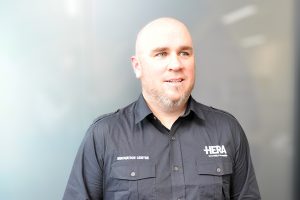Industry 4.0 technology proposed to ACC to augment and improve employees lives through use of wearable tech
 -Greg Buckley, Innovation and Transformation Architect, HERA
-Greg Buckley, Innovation and Transformation Architect, HERA
Late last year HERA, with industry partners, submitted an expression of interest to ACC’s Injury Prevention Fund, which invited EOIs specifically relating to innovation to reduce harm and injury in the workplace associated with psychosocial and mental health risks.
We have since engaged further with ACC and submitted a full proposal explaining how these risk factors could be reduced in sectors relating to our organisation through the use of Industry 4.0 technology.
The potential employee wellbeing and financial benefits from better management of psychosocial risk factors in higher-risk workplaces (such as construction and heavy engineering) are massive.
In 2020, approximately 170,000 workers were employed in the New Zealand construction sector, with the ACC-related cost of the construction sector totalling nearly $450m over the past three years.
HERA currently has 250 member organisations with around 25,000 workers in total, which equates to an approximate ACC cost per annum of nearly $22m.
What is HERA, with its partners in innovation, proposing to introduce with the support of ACC? A three-year programme of work, including ongoing research, which involves the deployment of wearable technology to track biological and physiological markers among employees who work in fields where heavy machinery is operated.
The programme is aligned with emerging research on the link between the stress response and bio-markers that indicates an individual’s propensity to psychosocial risk and negative mental health impacts.
By measuring health vitals such as heart rates and sleep cycles – as well as other bio-markers associated with stress – the wearable technology can track individual responses and overlay this data with survey data on mental health submitted by each employee.
It is an example of using wearable tech to gather and marry up data to optimise health and safety in the workplace.
If someone is showing signs of psychosocial risk such as fatigue, irritability or distractibility, they may be redeployed away from heavy machinery until those risk factors have dropped back to safe levels.
It means organisations can find ways to manage their workforce safely in a way that is transparent, allowing people to see the risk and how it is mitigated on a daily basis, as people are shifted to work that is better aligned with how they are currently functioning.
The design of this programme comes as we are achieving a real solidification of employers and employees recognising that most health and safety advances in the workforce will come from managing psychosocial risk properly – specifically ensuring, through the use of technology and reporting, that people are not tired, distracted, or disengaged.
This leads to a healthier, happier, safer workforce where people go home in one piece.
HERA would like to see people understand the role of technology to augment and improve employees’ lives. This is a great example of how we can deploy tech in that mode, with concrete data attached.
It is not about replacing people but creating as much value as we can for our workforce.
The thrust of all our innovation work in 4.0 technology is that the tech serves us, not the other way around, so everything is human-centric and focused on optimisation that simply makes people’s lives better.
As we prepare for further discussion with ACC we are working with organisations in the HERA membership to build this framework for tech to optimise people’s psychosocial risk profiles.
This explicitly supports ACC’s goals to bring down work-related harm and the associated costs, and this is a particularly important area because while innovation within the psychosocial space is challenging, and quantifying this risk in the workplace is difficult, it is where technological input into wellbeing strategies can deliver substantial real-world results and lasting changes in health and safety.
Within the HERA membership we are proud of the pivot that has been done in the past two years to improve staff wellbeing and be forward-thinking in how we care for people on and off the job.
Fortunately our members take a global view and see that wellbeing strategies aren’t just the right thing to do, but taking active, innovative steps to invest in workplace injury prevention offers an assurance to the market that this is an employer that is looking out for the best interests of employees.
In a competitive employment market this is a smart talent retention strategy, and a number of members are already doing it well and setting a standard for others to apply.
The use of wearable technology we are now proposing is a natural follow-on from existing programmes at a broader wellbeing level, and is a toolset that is even more quantifiable and measurable, allowing all parties, right up to ACC, to demonstrate the return on investment.
If you would like to find out more about Industry 4.0 and why it is an important part of HERA’s innovation work, visit our website www.hera.org.nz/industry40/. A recent Stirring the Pot podcast episode, The war against safety complacency, also explores the intersection of health and safety and technology.



